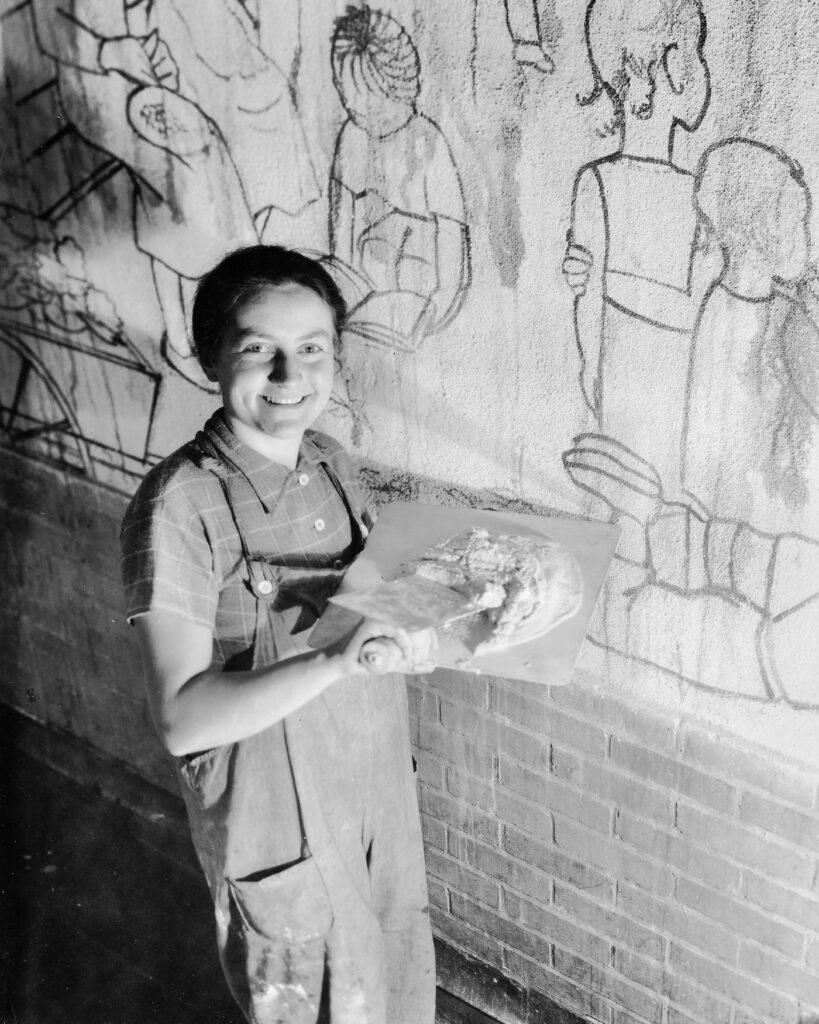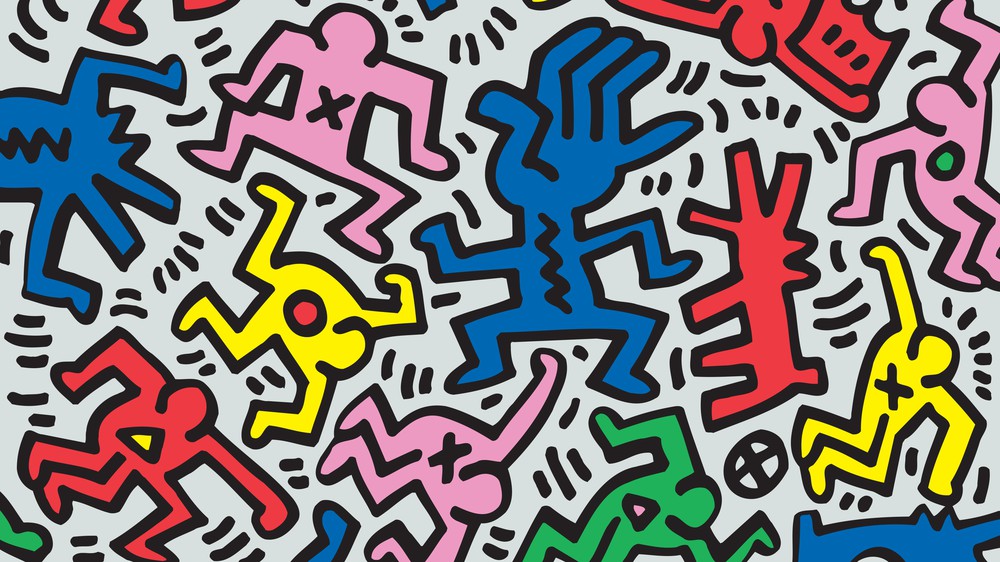The prolific contemporary artist “makes books, films, murals and other imaginings,” that speak to her deep interest for the marginalized, people, animals struggling to find their power.” Explore with me a series of murals she created for a residential community in South Brooklyn. In her murals, the viewer becomes lost in fantastical landscapes of graphic images and vivid colors.
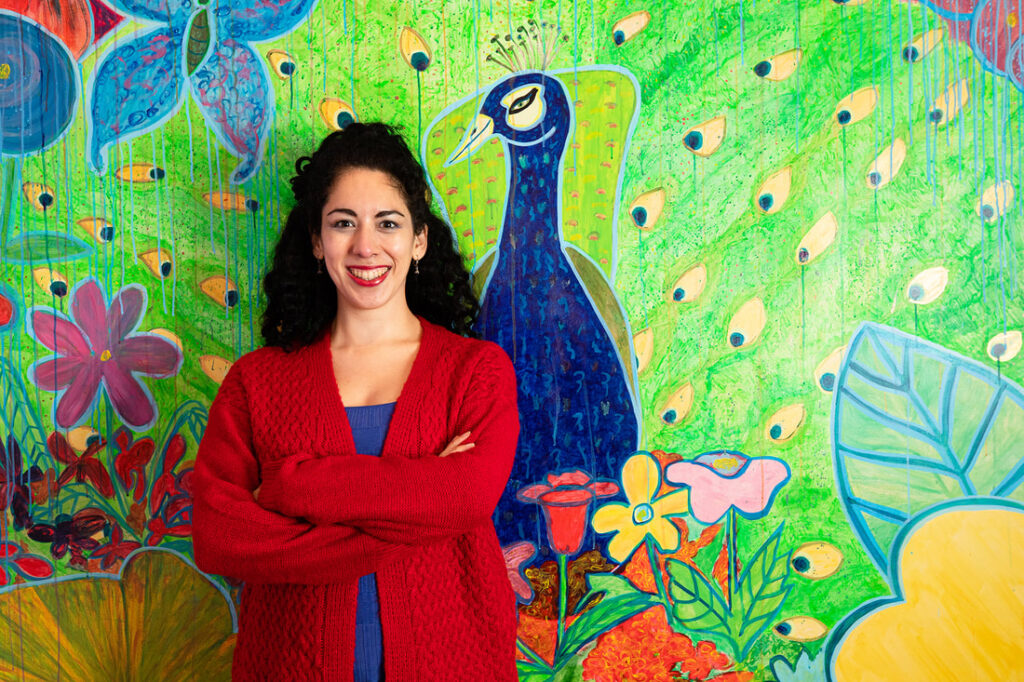
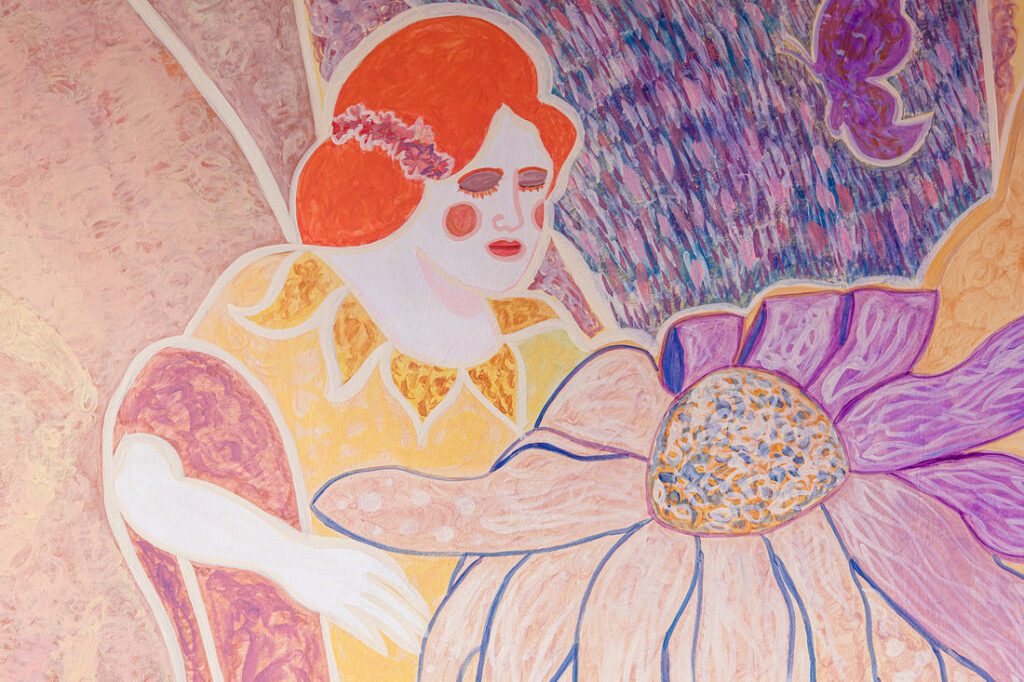
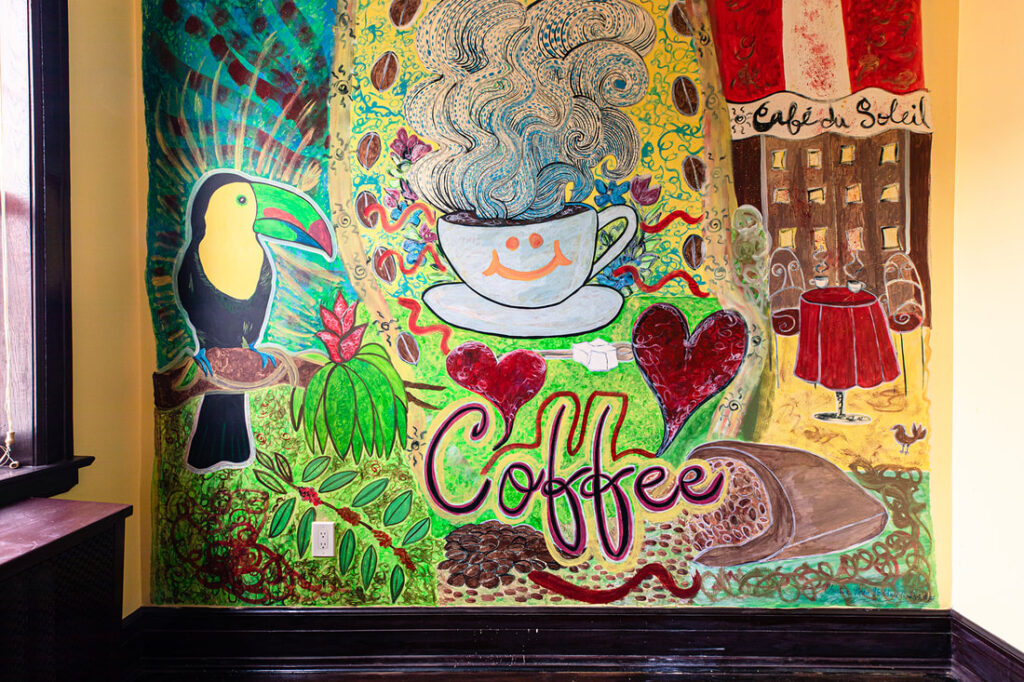
Other works highlighted in this episode include, Swoon, “Daniel/a,” Elienne Bloch (pictured with her work, “Cycle of a Woman’s Life,” and Keith Haring, “Untitled.”
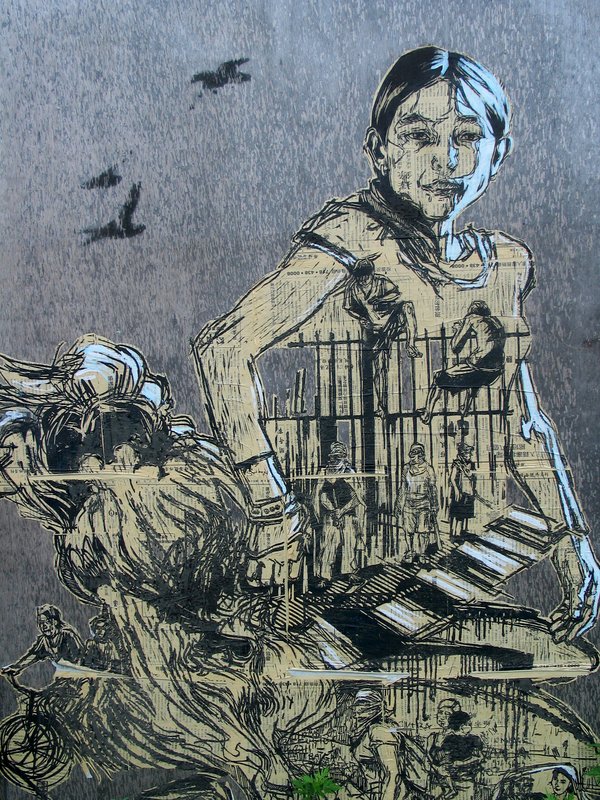
Resources for this episode include Christine Sloan Stoddard, Widewalls magazine, The Art Story, Callie Curry aka Swoon Ted Talk and the website Living New Deals. Photos by Shawn Inglima Photography
Script: The contemporary artist Christine Sloan Stoddard, in her artist statement on her website writes, “I make books, films, murals and other imaginings, including Quail Bell Press & Productions, known for Quail Bell Magazine and the Badass Lady-Folk podcast. Here is the part of her statement I love, “I tell stories with words, images, objects and my body. Come explore my world and find some magic along the way.”
Magical indeed. Christine has her hands and mind and creative spirit in so many avenues of art, both word and image. In this episode let’s journey and experience her unrestrained imagination, the “Magic” in her murals. I am especially excited because I was able to travel to South Brooklyn to see a series of a 10-mural commission, completed in December, 2020. The murals are located inside a group home owned by a large non-profit organization. I also had the gift of time with the artist who generously shared her process and insights into each work.
Before we dive into the series, let’s explore mural painting. “From the Latin murus, for wall, a mural is a painting made directly on the surface of a wall or painted on another surface that is then attached to the wall. It is one of the oldest and more artistic forms of persuasive communication that we have throughout the world. “The craft dates back, as far as we know, some 30,000 years to primitive cave illustrations in France, the elaborate tombs of Egyptian pharaohs–here they prepared their voyages to the other world by painting the walls of their tombs with salubrious images, and we can see garden vistas in the homes or villas of wealthy senators in balmy Pompeii. The art was elevated again throughout Italy during the Renaissance and modernized over the last century with the invention of new and advanced oil and water-based paints.
The popularity of the mural in the Western world began in the nineteenth century, with a new, community-orientated sense of national identity. The advantage of a mural is its accessibility to a large audience which has endeared it to many political ideologies. In the 1930s there was a worldwide trend towards making art more public in reaction to the introspective development of modern art. In Latin America, United States and Britain, mural painting became popular thanks to governmental sponsorship. In the United States, under President Franklin Roosevelt’s tenure, there was the Federal Art Project program. In the wake of the Wall Street crash, the Federal Art Project provided jobs for the unemployed, enabling many of the major American painters to survive during these difficult times. Artists in various media and levels of experience were funded. Murals were created for the embellishment of federal buildings like the post office.
Lucienne Bloch, for example, created “Cycle of a Woman’s Life” for the Women’s House of Detention in Greenwich Village in New York City, completed in 1936. The mural pictured a children’s playground in a working class neighborhood where black and white children play together as mothers watch and chat with each other. The theme, familiar to the prisoners, situated the playground in a cityscape of factories and skyscrapers that effectively block a view of the horizon. The underlying message related directly to the lives of Bloch’s audience, the women from the world of poverty, hunger and little formal education. Think about the powerful messaging embedded in the narrative of Bloch’s mural–its purpose goes beyond pure ornamentation of a bare wall.
By the 1970s murals in the Western world were engineered to local politics, often revealing a sense of national, racial or civic pride in the area. Murals have evolved in our modern times as important political statements like the works of Mexican muralist Diego Rivera and graffiti art–the Dean of the graffitists was Keith Haring. In his “deceptively simple imagery and text,” Haring provided poignant and cutting cultural commentary on issues, including AIDs, drug addiction. He was an activist communicating, through clean lines, simple images, in fresh and vivid colors using public sites like the New York Subway to share his messages. Keith Haring said, I love this quote, “One day, riding the subway, I saw this empty black panel where an advertisement was supposed to go. I immediately realized that this was the perfect place to draw.”
In our current contemporary arts world, women impart their social activism into the medium of the mural. Maya Hayuk is a feminist artist who will not work with galleries who exhibit less than 10% female artists. Hayuk is known for her massively scaled abstract murals characterized by intricate patterns, symmetrical compositions and super bright colors. Her work can be found all over the world.” writer is Asja Nastasijevic for Widewalls. One muralist I want to meet is Callie Curry aka tag name Swoon, activist and humanitarian, she is known for her life-sized wheat-paste prints, all hand cut, of highly detailed figures situated on walls and abandoned buildings in Brooklyn and Manhattan. Her work reflects the social and environmental issues and is inspired by both art historical and folks sources ranging from German Expressionist wood block prints to Indonesian shadow puppets.
In a Ted Talk Callie Curry aka Swoon shared how She studied painting at Pratt Institute but felt suffocated or constrained by the standard life of an artist. She said “I was going to paint some pictures that would end up on a wall, maybe that wall was in a gallery, maybe in a museum and that the only people who would see my work would be those who are comfortable going into galleries or who had enough money and sort of spare time to go to museums.” She said she was hungry for context and wanted to become part of something larger than herself–“I wanted to embrace the world and become a part of the world.” In her portraits of people who lived in the city, she changes street corners, in a concrete way, by pasting the portraits on blank walls of buildings. It transformed the building but also the way pedestrians react to the building. It changes the associations and connections they have with that space.
As I shared, murals in modern life are predominantly created for the public–a broad audience, works transform the landscape of our cities and buildings. Let’s turn our attention to the mural within a private space of a residential community. In the commission at the residential home, the murals are not for public consumption. They are not embedded with political messages or illuminate the viewer with social active commentary. Or as in Swoon’s work, transform the cityscape to engage the community.
I took a tour of several of the spaces or one-room apartments with the artist; they are currently empty. In each relatively small apartment a wall is dedicated to a mural. The recognizable images or graphics are large, the colors vivid the brushstrokes sweeping, images have thick contoured lines. Each space has a different theme. There is a collaborative aspect to each theme. The resident, whom Christine never meets and knows only by their first name, communicates with them through the Director of the organization . Usually the resident offers one or two words of the theme they want composed in their home. Fairies, Hair Accessories and Hearts, Garden, Music, Landscape, Sun are a few of the images expressed. From her imagination the artist creates fantastical landscapes of objects. My favorite is the Fairy themed mural. Bright orange and yellow, life sized fairies float, one gazes into the open petals of a flower.
In another mural, a large cup of coffee with an animated smile, from the top of the cup steam rolls towards the ceiling in thickly drawn waves, on one side is a Parisian-style cafe and on the other a delightful toucan bird is perched against the rolling hills of a farm. Christine describes the process: “I’d say I took the most creative license with the mural for Debra, whose room was painted yellow. “Coffee” was the only word that I was given and I was told she had no idea, theme, or preference beyond. So I included a toucan and coffee plants on a plantation, thinking to my mother’s memories of the coffee plantations in El Salvador. “
From another resident whose room was painted a bright Caribbean pink, her name is Elizabeth, Chrstine was told by the residence director she “wanted to have a mural with a flower garden. I asked if the mural could include a peacock and butterflies. The director asked Elizabeth, who agreed. That was the extent of Elizabeth’s input and I had freedom to interpret the colors and design from there.
Similarly, a man named José, whose room was painted a light olive green, asked for a radio. “I asked the director what sort of radio, such as the era or design, José wanted. I gave a few examples: a 1930s Art Deco radio, a boom box, etc. José opted for a boom box. Again, I had the creative freedom to paint the mural from there.”
Sloan Stoddard describes her murals as “energetic,” textural” composed from acrylic house paint and sometimes non-traditional media like found objects. for example In one mural of the Sun, she adds glitter to one of its winking eyes. Her style has been described as “contemporary take on Figurative Expressionism, infused with motifs from Magical Realism, the New York City graffiti scene and folk art.” All of her murals are done by hand–she uses no stencils or the hands of assistants.
Sloan Stoddard’s murals are composed for the private space and home. It is where a resident will rise and then retreat into sleep to large scale, floor to ceiling murals–magical images of personified sun winking, fluttering wings of fairies, a peacock boastfully spreading its wings across a garden of open flowers.
Imagine that for a moment; to live and breathe with art –Christine has a deep interest for the marginalized, people, animals struggling to find their power–as she writes, “in situations they desperately want to control.” The residents with intellectual disabilities may need to rely on organizations for their sustenance, but how it must enliven their spirits to breathe in their days with the lofty images and vivid colors from hand and imagination of the artist.
I want to share another aspect of her work–that of a poet and photographer. She showed me two published books of poetry and generously gifted me the volume “Heaven is a Photograph.” It is a collection of narrative poems and photographs that tells the story of an art student, her story is a journey of doubt, longing and questioning. The book is an invitation to “join her as she finds her power behind the lens.”
I want to read 2 poems that really captured my attention–both are accompanied by a photograph taken and composed by the artist.
As her words wash over you, the associations you make with both her words and image I am turn my microphone and invite you to join me in a short conversation with my guest and artist Christine Sloan Stoddard.

